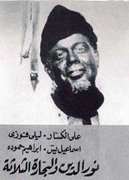العقل الكمي.. وخرافة الخرافة
إلي الصديق العزيز أسامة القفاش...
عم صباحا يا صديق، وأنعم بالا..
فأنت العارف والعارف لا يكدره شيء ، ويصفو له كل شيء
وأقول قول السهروردي
شربنا على روض الربيع المهفهف
فجاد لنا الساقي بصهباء قرقف
فلما شربناها و دب دبيبها
إلى موضع الأسرار قلت لها قفي
مخافة أن يسطو عليّ شعاعها
فيظهر جلاّسي على سريّ الخفي
رفرفة أجنحة جبريل
Second Review of Possible Roles of Neural Electron Spin Networks in Memory and Consciousness (2004 - 2006)
Hu, Huping, Ph.D, J.D.; and Wu, Maoxin, M.D.; M. Abbott, Ph.D.; F. abdalla, M.D., Ph.D.
Possible Roles of Neural Electron Spin Networks in Memory and Consciousness.
Abstract
Spin is the origin of quantum effects in both Bohm and Hestenes quantum formulism and a fundamental quantum process associated with the structure of space-time. Thus, we have recently theorized that spin is the mind-pixel and developed a qualitative model of consciousness based on nuclear spins inside neural membranes and proteins. In this paper, we explore the possibility of unpaired electron spins being the mind-pixels. Besides free O2 and NO, the main sources of unpaired electron spins in neural membranes and proteins are transition metal ions and O2 and NO bound/absorbed to large molecules, free radicals produced through biochemical reactions and excited molecular triplet states induced by fluctuating internal magnetic fields. We show that unpaired electron spin networks inside neural membranes and proteins are modulated by action potentials through exchange and dipolar coupling tensors and spin-orbital coupling and g-factor tensors and perturbed by microscopically strong and fluctuating internal magnetic fields produced largely by diffusing O2. We argue that these spin networks could be involved in brain functions since said modulation inputs information carried by the neural spike trains into them, said perturbation activates various dynamics within them and the combination of the two likely produce stochastic resonance thus synchronizing said dynamics to the neural firings. Although quantum coherence is desirable, it is not required for these spin networks to serve as the microscopic components for the classical neural networks. On the quantum aspect, we speculate that human brain works as follows with unpaired electron spins being the mind-pixels: Through action potential modulated electron spin interactions and fluctuating internal magnetic field driven activations, the neural electron spin networks inside neural membranes and proteins form various entangled quantum states some of which survive decoherence through quantum Zeno effects or in decoherence-free subspaces and then collapse contextually via irreversible and non-computable means producing consciousness and, in turn, the collective spin dynamics associated with said collapses have effects through spin chemistry on classical neural activities thus influencing the neural networks of the brain. Thus, according to this alternative model, the unpaired electron spin networks are the “mind-screen,” the neural membranes and proteins are the mind-screen and memory matrices, and diffusing O2 and NO are pixel-activating agents. Together, they form the neural substrates of consciousness.
Subjects:
Neuroscience > Biophysics
ID Code:
3544
Deposited On:
06 April 2006
References in Article
1. Marder, E., Abbott, L. F., Turrigiano, G. G., Liu, Z. & Golowasch, J. Memory from the dynamics of intrinsic membrane currents. Proc. Natl. Acad. Sci. USA. 1996; 93, 13481–13486.
2. Hunt, S. P. & Mantyh, P. W. The Molecular dynamics of pain control. Nature Rev. Neurosci. 2001; 2, 83–91.
3. Morais-Cabral, J. H., Zhou, Y. & MacKinnon, R. Energy optimisation of ion conduction rate by the K selectivity filter. Nature 2001; 414, 37–42.
4. Hu, H. P., & Wu, M. X. Spin-Mediated Consciousness Theory: possible roles of oxygen unpaired electronic spins and neural membrane nuclear spin ensemble in memory and consciousness. arXiv e-print 2002; quant-ph/0208068.
5. Hu, H. P., & Wu, M. X. Spin-Mediated Consciousness Theory: an approach based on pan-protopsychism. Cogprints 2003; ID2579.
6. Hu, H. P., Wu, M. X., & F. Abdalla. Spin as primordial self-referential process driving quantum mechanics, spacetime dynamics and consciousness. NeuroQuantology 2004; 1:41-49.
7. Hu, H. P., & Wu, M. X. Action Potential Modulation of Neural Spin Networks Suggests Possible Role of Spin. Cogprints 2004; ID3458.
8. Wertz, J. E., Bolton J. R. Electron Spin Resonance: Elementary theory and practical application (New York: McGraw-Hill Book Company, 1972).
9. Dirac, P. A. M. The quantum theory of the electron. Proc. R. Soc. A , 1928; 117: 610-624.
10. Penrose, R. A spinor approach to general relativity. Ann. Phys., 1960; 10: 171.
11. Penrose, R. Twistor algebra. J. Math. Phys., 1967; 8: 345.
12. Hestenes, D. Quantum mechanics from self-interaction. Found. Physics, 1983; 15: 63-


